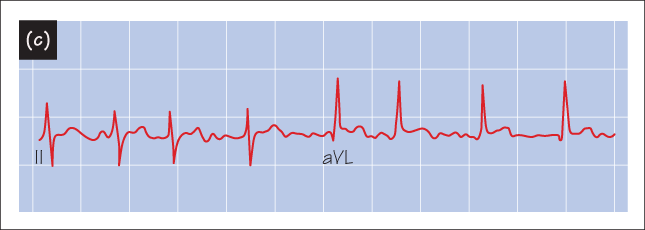-
(a) What is the ventricular rate in Figure Case 4 (a)? Is this a ventricular or supraventricular arrhythmia?
Show Answer
The ventricular rate is 150 beats/min. The narrow QRS complex implies that the tachycardia is supraventricular. The differential diagnosis for this tachycardia includes AV nodal (AVN) re-entrant tachycardia, atrial flutter or sinus tachycardia. Atrial fibrillation is unlikely because the rhythm is regular.
-
(b) Based on the effect of carotid sinus massage, what is the diagnosis? How does carotid sinus massage affect the ventricular response?
Show Answer
Carotid sinus massage demonstrates the sawtooth pattern of flutter waves, particularly in the inferior leads (II, III, aVF). This proves that the initial rhythm was atrial flutter with 2 : 1 conduction (i.e. only one of every two atrial waves is conducted through the AVN to the ventricle). Because the flutter waves have a rate of nearly 300 beats/min, the ventricular rate is 150 beats/min. Carotid sinus massage increases vagal tone, slowing conduction through the AVN and increasing AV block.
-
(c) What pharmacological agents can be used to slow the ventricular response?
Show Answer
Beta -blockers, digoxin, Ca2+-channel blockers and adenosine slow conduction through the AVN. This slows the ventricular rate, allowing adequate time for left ventricular filling and relieving the symptoms of left heart failure (shortness of breath, weakness, orthopnoea).
- Results of treatment The patient is admitted to hospital and begun on digitalis and amiodarone. The next morning he feels better, but his pulse is irregularly irregular with an apical pulse of 110 and a radial pulse of 70. An ECG is shown in Figure Case 4 (c).
-
(d) What is the rhythm now? Is the change from the day before common?
Show Answer
This is atrial fibrillation; note the irregularly irregular ventricular rate. Atrial flutter is an unstable rhythm, and commonly degenerates into atrial fibrillation.
-
(e) Is the current anti-arrhythmic regimen appropriate?
Show Answer
Yes. Amiodarone and digoxin are commonly used to treat atrial arrhythmias. Digoxin helps to slow the ventricular rate by increasing vagal tone at the AVN. Amiodarone similarly helps to slow the ventricular response. Amiodarone is also used to cardiovert patients with atrial arrhythmias back into sinus rhythm and/or help maintain sinus rhythm once they have been electrically cardioverted.
-
(f) What other therapy may be indicated? Why?
Show Answer
Patients with intermittent or persistent atrial fibrillation should receive anticoagulation because of the risk of embolic stroke. In this patient, who seems to be having his first episode of atrial fibrillation, electrical cardioversion should be attempted if amiodarone does not convert the rhythm to sinus.


